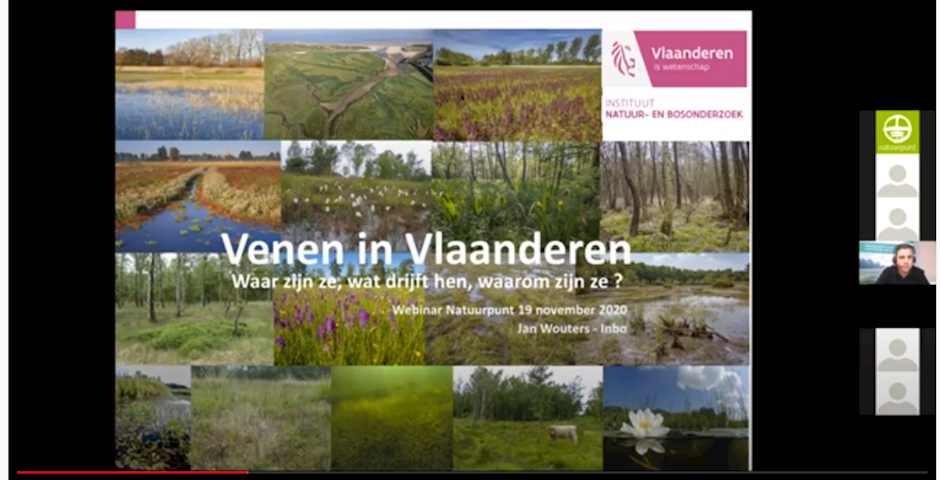
Relive the Peatland Policy workshop in Flanders (Belgium)

On 19 November 2020, Natuurpunt organised the symposium 'Veen in Vlaanderen' (Peat in Flanders). Over the span of 1.5 hours, Flemish peat experts from the University of Antwerp (UA) and the Institute for Nature and Forest Research (INBO) told the 180 registered participants via Zoom about the opportunities and obstacles that stand in the way of successful peat restoration.
After all, the environment policy document of the Flemish government makes clear: our wetlands and marshes, particularly peatlands, are an area of opportunity and have the great potential to contribute to positive change. In addition to providing critical services such as flood protection, drought prevention and purification of drinking water, these systems are critical to the protection of the water biodiversity and combating climate change. Peatlands are the most efficient carbon storage system, covering only 3% of the world’s land surface, but capturing more than a quarter of all carbon in the ground.
Overview of presentations and speakers
Rudy van Diggelen (University of Antwerp) - Restoring the ecosystem services of an underrated landscape type
The symposium started with peat expert Rudy van Diggelen. Rudy works as a professor for the Ecosystem Management research group at the University of Antwerp. Rudy took on the topic area "science" in his presentation. He set the scene for the following presenters by introducing the audience to what peat is, ecosystem services from peat to nature and climate, and threats to the Flemish and international peat ecosystems. Rudy also provided a closer look at initiatives that include peat protection outside nature reserves, for example Paludiculture. The presentation ended with the conclusion that the preservation and recovery of Flemish peatlands is extremely urgent. Which implies protection of all non-drained bogs and rewetting of all drained bogs.
Jan Wouters (INBO) - Peatlands in Flanders - Where are they, what drives them, why are they there?
The second speaker was Jan Wouters who has been working at INBO for 17 years, currently as part of their Environment and Climate team. In his presentation he focused on the rather critical state of Flemish bogs, but also on the encouraging outlook including possibilities to develop and recover peat land.
Kris Decleer (INBO) - Peat recovery in Flanders - (Doom and gloom) challenges for policy
The symposium ended with Kris Decleer. He is a landscape ecologist at INBO as part of the Landscape Ecology and Nature Management team and is involved with Care-Peat as a peat expert. He too has a special interest in the management and restoration of wetlands. His publication Decleer et al. (2016), is a in policy circles frequently used guide for area-oriented peat restoration. Kris covered the policy section of this webinar and focused on the levers that we should overcome, and which instruments we need in Flanders to make peat restoration a success
As part of the webinar, an interactive exchange between participants and experts took place, during which necessary levers for successful peatland restoration in Flanders to realise nature and climate benefits were identified.
Conclusions and next steps
Peatlands are unique ecosystems and Flanders has a great responsibility to protect them
To minimise the contribution of drained peat soils to global warming, peaty soils need to be preserved, for which the land needs to stay saturated. This translates into the need for adapted land use including for instance a ban on drainage, switch to Paludiculture, etc.
The next step is to expand and restore peat areas by rewetting them and the restoration of the hydrological system at the landscape level. Meaning that peat bodies need to receive sufficient water, either through seepage or from rainwater and that drainage should be minimal. Which in turn implies the need, for example, for setting up buffer areas with specific measures (such as slower drainage).
In order to optimally focus on peat conservation in Flanders, a policy with sufficient possibilities to impose measures and allocate financing should be developed.
There is the need for a "Flemish peat platform" with the aim of working together with multiple stakeholders to create jointly supported initiatives. We strive for a consortium in which the commitment to peat restoration is paramount to all parties.
